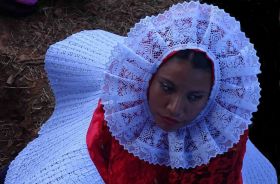What is the culture of Mexico?
Brenda de Groot - AvensaTravel
 Mexico has a very rich culture. Here in Oaxaca, there are still a lot of traditions and customs and people still follow them. I find it very beautiful and I think it makes people falling in love easily with the city!
Mexico has a very rich culture. Here in Oaxaca, there are still a lot of traditions and customs and people still follow them. I find it very beautiful and I think it makes people falling in love easily with the city! (Girl in traditional dress from the Istmo de Tehuantepec, Oaxaca, Mexico, pictured right.)
Mexico original population were different old cultures, like the Olmecs, Mixtecs, Mayas, Zapotecs and the Aztecs. All lived in different regions and...
 Mexico has a very rich culture. Here in Oaxaca, there are still a lot of traditions and customs and people still follow them. I find it very beautiful and I think it makes people falling in love easily with the city!
Mexico has a very rich culture. Here in Oaxaca, there are still a lot of traditions and customs and people still follow them. I find it very beautiful and I think it makes people falling in love easily with the city! (Girl in traditional dress from the Istmo de Tehuantepec, Oaxaca, Mexico, pictured right.)
Mexico original population were different old cultures, like the Olmecs, Mixtecs, Mayas, Zapotecs and the Aztecs. All lived in different regions and peaked in different times. In the 16 century the Spaniards came to Mexico and they conquered the powerful Aztec regime. Mexican culture today is a mix of the many old Mexican cultures with the Spanish (catholic) culture. This mix is reflected in people´s customs and traditions. In the south of Mexico, old languages like zapotec are still spoken in many rural areas and villages outside the city.
Mexican cuisine is an important part of the Mexican culture. People here normally eat three times a day a big meal! Eating is a very important aspect of the family getting together. In Mexico, food, eating and spending time with family is very important. If people ask you to come over to their house they always offer you food. At weddings, they serve you, most of the time, twice a big meal, to avoid people leaving hungry!
There are still many traditional cultures living in Mexico and in Oaxaca traditions are still happening every day. When children get baptized, have their confirmation, turn 15 year old, get married, they have rituals and customs for each festival . Also the villages have many celebrations to honor their village, their religion and specific virgins. In the city of Oaxaca, you can see often parades with flowers, music and dancing because here there are often reasons to celebrate!
When a girl turns 15, she will have the most important party of her life. This party is most of the time even bigger and more special than her future wedding. During her party she will have to perform certain dances; one of these is a dance where she will say goodbye to her doll and start dancing with a boy!
Another example of one of the rituals in the villages is that if a girl falls in love, the family of the boy will have to bring a lot of offers like candles, bread, flowers, corn, food, even wash machines! They give these offers to the family of the girl as a respect to the girl´s family, as their daughter fell in love and wants to get married with their son! The family of the boy will give speeches and will promise the family of the girl that they will take good care of her.

Another custom here in Oaxaca, is to have many godparents. When people get married or give another kind of party, it´s common that they ask several godparents to help them with the party. They have different godparents for the dress, the cake, the rings, the table decorations, the music band, for the second day party, and even for the third day party! Before the wedding the couple goes to visit their relatives and family and will ask them to be their godparents on their wedding. For the selected people it is almost impossible to say “no” because they will feel very honored if they have been asked by a couple to be their godparent ,even if that also means that you are going spend a lot of money!
(A fiesta in Oaxaca, Mexico, pictured right.)
The culture is still very traditional and respectful. People are very respectful especially to the elder. If you don’t know a person or you speak to an older person, you use polite words such as usted rather than tu. Both mean “you” but usted is the more polite form of the word. There is no English equivalent to usted. Mexicans always use the polite form when addressing someone, but in Spain, for example the people don’t use usted so often anymore.
The culture is still very traditional and respectful. People are very respectful especially to the elder. If you don’t know a person or you speak to an older person, you use polite words such as usted rather than tu. Both mean “you” but usted is the more polite form of the word. There is no English equivalent to usted. Mexicans always use the polite form when addressing someone, but in Spain, for example the people don’t use usted so often anymore.
Posted October 16, 2015



.png)